The double zinc finger domain and adjacent accessory domain from the transcription factor loss of zinc sensing 1 (loz1) are necessary for DNA binding and zinc sensing
- PMID: 24831008
- PMCID: PMC4140304
- DOI: 10.1074/jbc.M114.551333
The double zinc finger domain and adjacent accessory domain from the transcription factor loss of zinc sensing 1 (loz1) are necessary for DNA binding and zinc sensing
Abstract
The Loz1 transcription factor from Schizosaccharomyces pombe plays an essential role in zinc homeostasis by repressing target gene expression in zinc-replete cells. To determine how Loz1 function is regulated by zinc, we employed a genetic screen to isolate mutants with impaired zinc-dependent gene expression and analyzed Loz1 protein truncations to map a minimal zinc-responsive domain. In the screen, we isolated 36 new loz1 alleles. 27 of these alleles contained mutations resulting in the truncation of the Loz1 protein. The remaining nine alleles contained point mutations leading to an amino acid substitution within a C-terminal double zinc finger domain. Further analysis of two of these substitutions revealed that they disrupted Loz1 DNA activity in vitro. By analyzing Loz1 protein truncations, we found that the last 96 amino acids of Loz1 was the smallest region that was able to confer partial zinc-dependent repression in vivo. This 96-amino acid region contains the double zinc finger domain and an accessory domain that enhances DNA binding. These results were further supported by the findings that MtfA, a transcription factor from Aspergillus nidulans that contains a related double zinc finger, is unable to complement loz1Δ, whereas a chimera of MtfA containing the Loz1 accessory domain is able to complement loz1Δ. Together, our studies indicate that the double zinc finger domain and adjacent accessory domain preceding zinc finger 1 are necessary for DNA binding and zinc-dependent repression.
Keywords: Metal Homeostasis; Metallosensor; Transcription Repressor; Yeast Genetics; Zinc; Zinc Finger.
© 2014 by The American Society for Biochemistry and Molecular Biology, Inc.
Figures
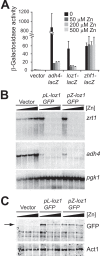
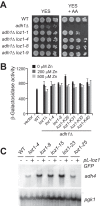


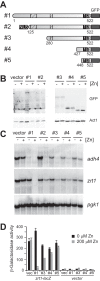
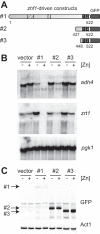
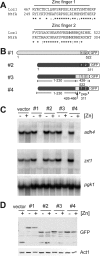
Similar articles
-
The Loz1 transcription factor from Schizosaccharomyces pombe binds to Loz1 response elements and represses gene expression when zinc is in excess.Mol Microbiol. 2019 Dec;112(6):1701-1717. doi: 10.1111/mmi.14384. Epub 2019 Sep 24. Mol Microbiol. 2019. PMID: 31515876 Free PMC article.
-
Zinc finger protein Loz1 is required for zinc-responsive regulation of gene expression in fission yeast.Proc Natl Acad Sci U S A. 2013 Sep 17;110(38):15371-6. doi: 10.1073/pnas.1300853110. Epub 2013 Sep 3. Proc Natl Acad Sci U S A. 2013. PMID: 24003116 Free PMC article.
-
Conformational dynamics in specialized C2H2 zinc finger domains enable zinc-responsive gene repression in S. pombe.Protein Sci. 2025 Feb;34(2):e70044. doi: 10.1002/pro.70044. Protein Sci. 2025. PMID: 39865413 Free PMC article.
-
Zinc sensing and regulation in yeast model systems.Arch Biochem Biophys. 2016 Dec 1;611:30-36. doi: 10.1016/j.abb.2016.02.031. Epub 2016 Mar 3. Arch Biochem Biophys. 2016. PMID: 26940262 Free PMC article. Review.
-
Zinc'ing sensibly: controlling zinc homeostasis at the transcriptional level.Metallomics. 2014 Jul;6(7):1198-215. doi: 10.1039/c4mt00064a. Metallomics. 2014. PMID: 24722954 Review.
Cited by
-
The Loz1 transcription factor from Schizosaccharomyces pombe binds to Loz1 response elements and represses gene expression when zinc is in excess.Mol Microbiol. 2019 Dec;112(6):1701-1717. doi: 10.1111/mmi.14384. Epub 2019 Sep 24. Mol Microbiol. 2019. PMID: 31515876 Free PMC article.
-
Zinc-dependent activation of the Pho8 alkaline phosphatase in Schizosaccharomyces pombe.J Biol Chem. 2019 Aug 16;294(33):12392-12404. doi: 10.1074/jbc.RA119.007371. Epub 2019 Jun 25. J Biol Chem. 2019. PMID: 31239353 Free PMC article.
-
The gluconate shunt is an alternative route for directing glucose into the pentose phosphate pathway in fission yeast.J Biol Chem. 2017 Aug 18;292(33):13823-13832. doi: 10.1074/jbc.M117.798488. Epub 2017 Jun 30. J Biol Chem. 2017. PMID: 28667014 Free PMC article.
-
Transcription factors and transporters in zinc homeostasis: lessons learned from fungi.Crit Rev Biochem Mol Biol. 2020 Feb;55(1):88-110. doi: 10.1080/10409238.2020.1742092. Epub 2020 Mar 19. Crit Rev Biochem Mol Biol. 2020. PMID: 32192376 Free PMC article. Review.
-
A pathway for low zinc homeostasis that is conserved in animals and acts in parallel to the pathway for high zinc homeostasis.Nucleic Acids Res. 2017 Nov 16;45(20):11658-11672. doi: 10.1093/nar/gkx762. Nucleic Acids Res. 2017. PMID: 28977437 Free PMC article.
References
-
- Andreini C., Bertini I. (2012) A bioinformatics view of zinc enzymes. J. Inorg. Biochem. 111, 150–156 - PubMed
-
- Klug A. (2010) The discovery of zinc fingers and their applications in gene regulation and genome manipulation. Annu. Rev. Biochem. 79, 213–231 - PubMed
-
- Ehrensberger K. M., Bird A. J. (2011) Hammering out details: regulating metal levels in eukaryotes. Trends Biochem. Sci. 36, 524–531 - PubMed
MeSH terms
Substances
LinkOut - more resources
Full Text Sources
Other Literature Sources
Molecular Biology Databases
Research Materials

